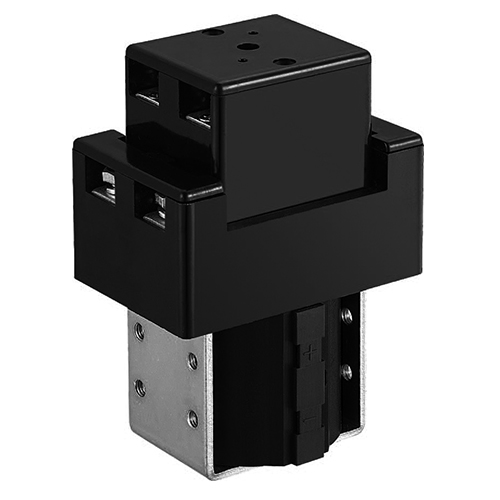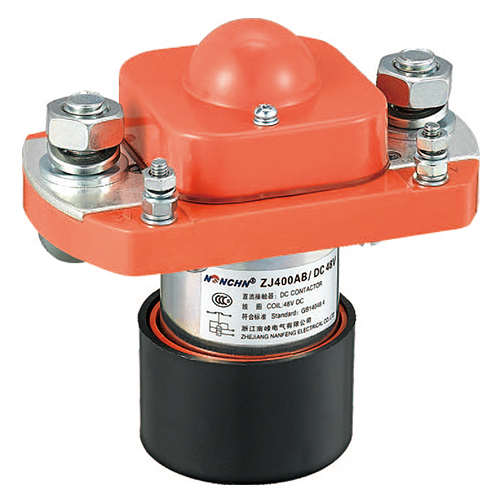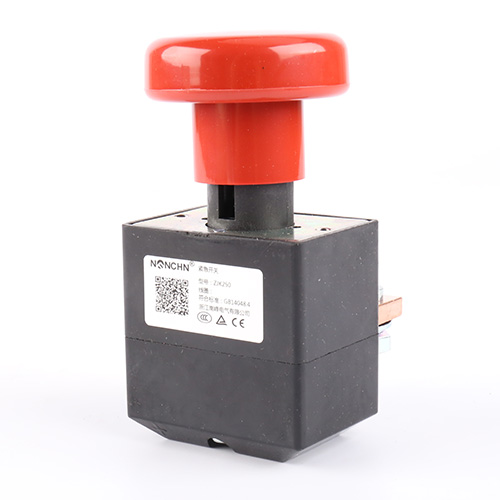A DC contactor is an essential switching device used to control high-current direct-current (DC) circuits safely and efficiently. It enables reliable connection and disconnection of power in demanding applications such as electric vehicles, renewable energy systems, and industrial automation.
What’s a DC Contactor
A DC contactor is an electrical switching device specifically designed for use in direct current (DC) circuits. Its primary function is to control the on/off state of high-power DC electrical equipment, enabling remote or automatic control without the need for manual operation. Unlike AC contactors, which operate on alternating current and leverage the natural zero-crossing point of AC to extinguish arcs, DC contactors face greater challenges in arc suppression due to the unidirectional and continuous nature of DC current. This makes their design, particularly the arc-extinguishing mechanism, crucial for safe and reliable operation. DC contactors are widely used in various fields where precise and efficient control of DC power is required, serving as a key component in power distribution and equipment control systems.
The Structure of DC Contactor
A typical DC contactor consists of several essential components, each playing a vital role in its overall functionality:
-
Electromagnetic System: This is the driving force behind the contactor's operation. It comprises an iron core, a coil, and an armature. When an electric current passes through the coil, it generates a magnetic field that magnetizes the iron core, attracting the armature. The electromagnetic system's design ensures sufficient magnetic force to overcome the spring force and move the armature, which in turn operates the contacts.
-
Contact System: The contact system is responsible for conducting or interrupting the DC current. It includes main contacts and auxiliary contacts. Main contacts are designed to handle the high current of the main circuit, while auxiliary contacts are used for control circuit signaling or interlocking purposes. The contacts are typically made of materials with high electrical conductivity and wear resistance, such as copper alloys, to ensure long-term reliable operation.
-
Arc-Extinguishing Device: Given the difficulty in extinguishing DC arcs, this component is critical. Common arc-extinguishing methods for DC contactors include magnetic blowout and arc chutes. Magnetic blowout uses a magnetic field to blow the arc into the arc chute, where it is split and cooled, accelerating arc extinction. Arc chutes are composed of insulating plates that create multiple small gaps to break the arc into segments, increasing the arc voltage and facilitating extinction.
-
Housing: The housing is made of insulating materials, such as plastic or bakelite, which provide mechanical protection for the internal components, prevent electrical shock, and isolate the contactor from external dust, moisture, and other contaminants.
Working Principle of DC Contactors
Coil Energizing: When voltage is applied to the electromagnetic coil, it generates a magnetic field.
Armature Movement: The magnetic field pulls the armature toward the coil core.
Contact Closure: The moving contacts close against the fixed contacts, completing the circuit and allowing current to flow.
Coil De-energizing: When coil power is removed, a spring pushes the armature back to its original position.
Arc Handling (During Opening): When breaking a DC circuit, an arc forms between the contacts. The contactor’s arc chamber extinguishes it quickly to ensure safety.
Applications of DC Contactors
DC contactors are widely applied in various industries and fields due to their ability to control high-power DC circuits. Some common application areas include:
-
Electric Vehicles (EVs): In EVs, DC contactors are used to control the main circuit of the battery pack, connecting or disconnecting the battery from the motor controller. They also play a role in the charging circuit, ensuring safe charging and discharging of the battery.
-
Energy Storage Systems: Energy storage systems, such as lithium-ion battery energy storage systems, rely on DC contactors to manage the charging and discharging processes of the battery bank. They help switch between different operating modes and protect the system from overcurrent and overvoltage.
-
Industrial Automation: In industrial settings, DC contactors are used in DC motor control, such as in conveyor systems, cranes, and hoists. They enable the start, stop, and direction reversal of DC motors, providing precise control over industrial equipment.
-
Rail Transit: DC contactors are essential components in rail transit systems, such as subway trains and trams. They are used to control the power supply to the traction motor, as well as in auxiliary circuits for lighting, air conditioning, and other equipment.
-
Renewable Energy Systems: In renewable energy systems like solar photovoltaic (PV) systems, DC contactors are used to connect the PV panels to the inverter or energy storage system. They help protect the system from faults and ensure efficient power transmission.
How to choose a suitable DC contactor
Selecting the right DC contactor is crucial for ensuring the safe and reliable operation of the electrical system. The following factors should be considered when making a choice:
-
Rated Voltage: The rated voltage of the DC contactor should be greater than or equal to the maximum voltage of the circuit it will control. This prevents insulation breakdown and ensures safe operation.
-
Rated Current: The rated current of the contactor should match or exceed the normal operating current of the load. It is also necessary to consider the inrush current when the load starts, as some loads have high inrush currents that may damage the contactor if not accounted for.
-
Load Type: Different load types have different characteristics. Inductive loads, such as motors, generate high back EMF when the contactor is disconnected, which can cause arc damage. Therefore, contactors designed for inductive loads should have better arc-extinguishing capabilities.
-
Environmental Conditions: The operating environment, including temperature, humidity, altitude, and presence of dust or corrosive gases, should be considered. Contactors with appropriate protection ratings should be selected to ensure they can operate normally in the given environment.
-
Arc-Extinguishing Ability: As DC arcs are more difficult to extinguish, the arc-extinguishing device of the contactor is a key factor. For high-current or high-voltage circuits, contactors with efficient arc-extinguishing mechanisms should be chosen.
-
Control Circuit Voltage: The voltage of the control circuit should match the rated voltage of the contactor's coil. Using the correct control voltage ensures the contactor operates reliably.
-
Mechanical Life and Electrical Life: The mechanical life (number of on/off cycles without load) and electrical life of the contactor should meet the requirements of the application. Choosing a contactor with a long service life reduces maintenance costs and downtime.
Conclusion
A DC contactor is a critical switching component used to control high-current DC circuits across various industries. With its specially designed structure, strong arc-suppression capability, and robust switching performance, it plays an important role in EVs, renewable energy, industrial automation, and power backup systems. By understanding its working principles and selection criteria, users can choose the most suitable DC contactor for their applications.
FAQ
Q: Can a DC contactor be used in an AC circuit? A: No, DC contactors are not suitable for AC circuits. AC has a zero-crossing point that helps extinguish arcs, while DC does not. Using a DC contactor in an AC circuit may result in poor arc extinction, leading to contact damage and potential safety hazards.
Q: How to judge if a DC contactor is faulty? A: Common fault symptoms include failure to close or open, abnormal noise during operation, excessive heating, and arc discharge between contacts. You can check the coil voltage, contact resistance, and arc-extinguishing device for damage to determine the fault cause.
Q: What factors affect the service life of a DC contactor? A: The service life is affected by factors such as the number of on/off cycles, load current and voltage, operating environment (temperature, humidity), and arc-extinguishing performance. Proper maintenance and selection of a contactor matching the application conditions can extend its service life.
Q: Is it necessary to install a protective device with a DC contactor? A: Yes, it is recommended to install protective devices such as fuses, circuit breakers, or overcurrent relays. These devices can protect the DC contactor and the circuit from overcurrent, overvoltage, and short-circuit faults, enhancing the safety and reliability of the system.






